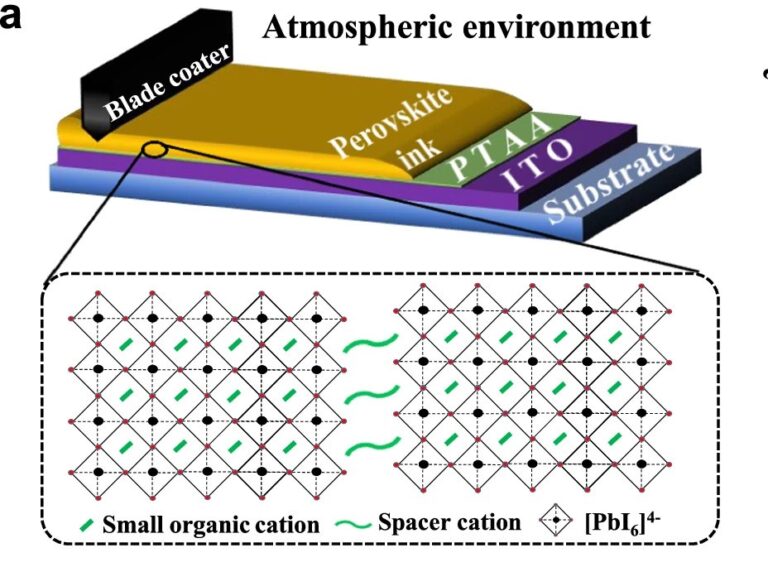Chinese researchers claim to have developed an ‘ultra-stable’ perovskite solar cell based on a two-dimensional perovskite in the Dion-Jacobson phase. The device is built with blade coating technology and is scalable, according to the makers.
Researchers led by China’s National Center for Nanoscience and Technology have developed a 2D Dion-Jacobson (DJ) perovskite solar cell that reportedly exhibits high levels of stability while achieving an energy conversion efficiency of 19.11%.
Two-dimensional (2D) Dion-Jacobson (DJ) phase perovskites have attracted interest in the scientific community due to their stability against harsh environmental conditions and their competitive performance in optoelectronic applications. However, solar cells based on DJ perovskites have shown relatively poor performance compared to their 3D counterparts.
For its cell, the Chinese group used a perovskite material known as (CDMA)(MA)n−1PbnI3n+1, where CDMA stands for 1,4-cyclohexane dimethanammonium. “Structural analyzes show that these materials have an extremely small interlayer quantum well configuration distinct from most DJ perovskites, which can reduce interlayer spaces and tune their mutual alignment to facilitate interlayer charge transport and structural stability,” said the researchers.
The device is built with blade coating technology and is scalable, according to the academics. It was built with a glass and indium tin oxide (ITO) substrate, a hole transport layer (HTL) based on poly[bis(4-phenyl)(256-trimethylphenyl)amine(PTAA)CDMA-basedDJperovskitelayerandabuckminsterfullerene(C60)electrontransportlayer(ETL))abathocuproine(BCP)bufferlayerandatopelectrodemadeofsilver(Ag)[bis(4-phenyl)(256-trimethylphenyl)amine(PTAA)CDMA-basedDJperovskitelayerabuckminsterfullerene(C60)electrontransportlayer(ETL)abathocuproine(BCP)bufferlayerandtopelectrodemadeofsilver(Ag)[bis(4-fenyl)(256-trimethylfenyl)amine(PTAA)CDMA-gebaseerdeDJ-perovskietlaageenbuckminsterfullereen(C60)elektronentransportlaag(ETL)eenbathocuproïne(BCP)bufferlaageneentopelektrodegemaaktvanzilver(Ag)[bis(4-phenyl)(256-trimethylphenyl)amine(PTAA)CDMA-basedDJperovskitelayerabuckminsterfullerene(C60)electrontransportlayer(ETL)abathocuproine(BCP)bufferlayerandatopelectrodemadeofsilver(Ag)
For reference, the group also created a similar cell with a change in the DJ perovskite layer. While the new structure was based on CDMA, the reference cell was based on PDMA, which stands for 1,4-phenylenedimethanammonium. PDMA DJ has a similar organic molecular configuration to CDMA materials, but they have been studied on a larger scale.
Tested under standard lighting conditions, the CDMA DJ cell achieved an efficiency of 19.11%, an open-circuit voltage of 1.16 V, a short-circuit current density of 20.41 mA cm−2 and a fill factor of 80.56%. The reference PDMA DJ device achieved an efficiency of 14.87%, an open-circuit voltage of 1.06 V, a short-circuit current density of 18.32 mA cm−2, and a fill factor of 76.46%.
“Importantly, fabricated cells also exhibit remarkable humidity, thermal and operational stability,” the group points out. “After being held in 90% or 85 C relative humidity for more than 4,000 hours and 5,000 hours, respectively, the devices showed an 8% deterioration for the humidity stability test and a negligible efficiency loss for the thermal stability measurement. In particular, operational stability under continuous light loads shows negligible efficiency loss above 6000 hours.”
Concluding the paper, the scientists added that “the designed interlayer displacement DJ series provides a significant and potential path for constructing new structurally stable 2D perovskites. The application of blade coating of the designed DJ perovskite solar cells could stimulate new developments in scalable technology and its commercialization process.”
The new cell architecture was introduced in “Ultra-stable and efficient 2D Dion-Jacobson perovskite solar cells with slight interlayer displacement,” published in Nature communication. The research team included scientists from China National Center for Nanoscience and Technology, University of South China, Chinese Academy of Sciences, Beijing Technology And Business University and Beihang University.
This content is copyrighted and may not be reused. If you would like to collaborate with us and reuse some of our content, please contact: editors@pv-magazine.com.


